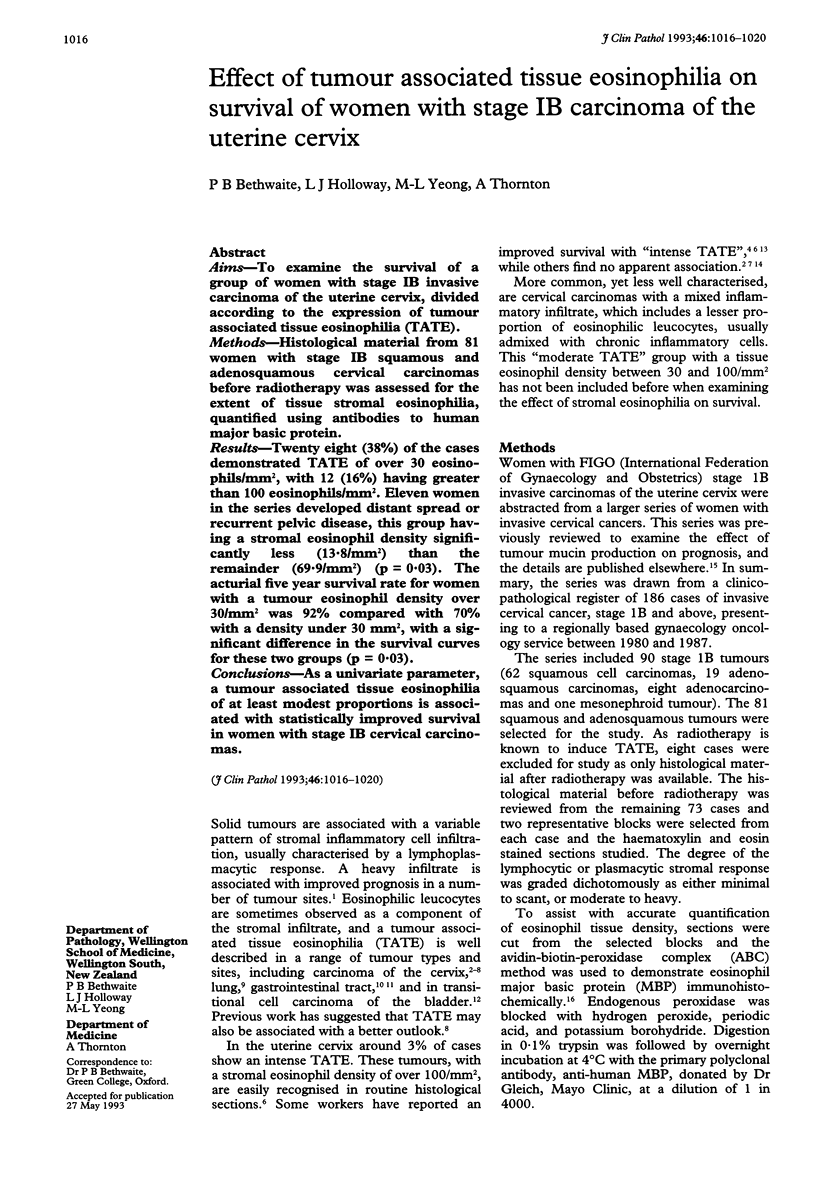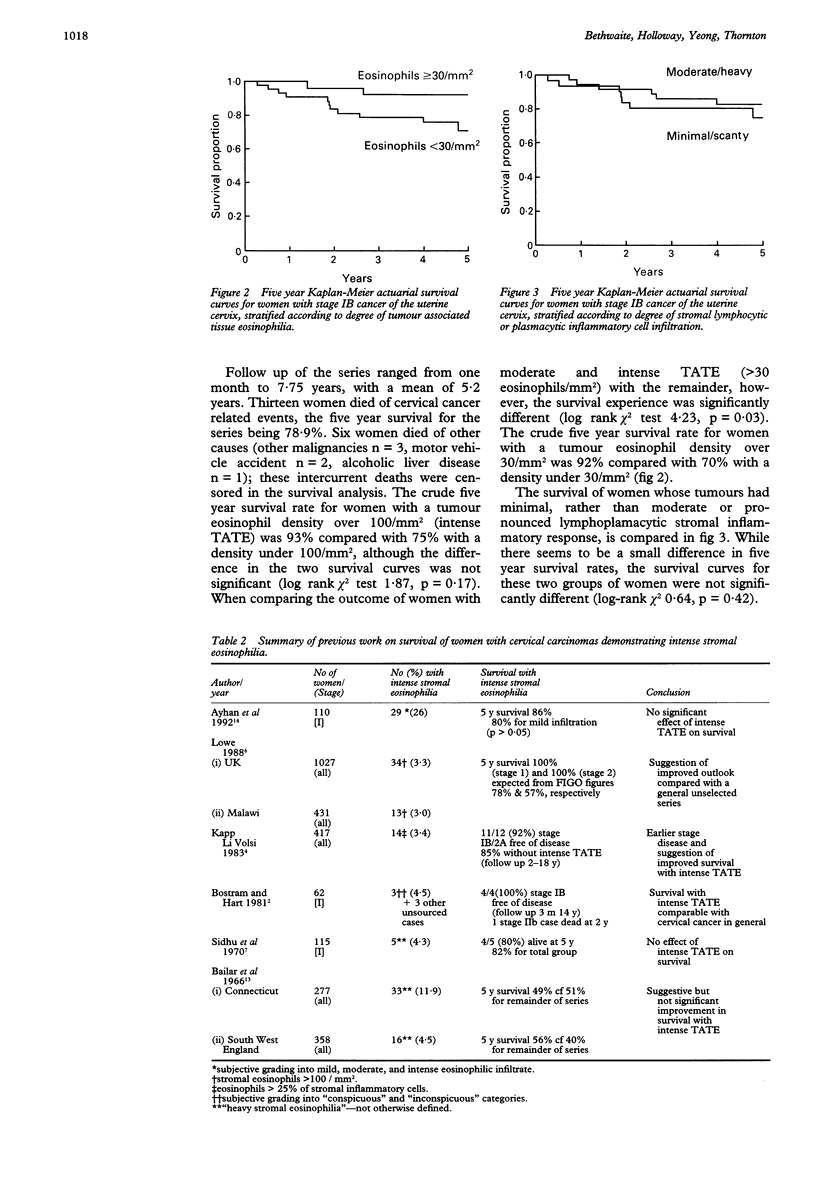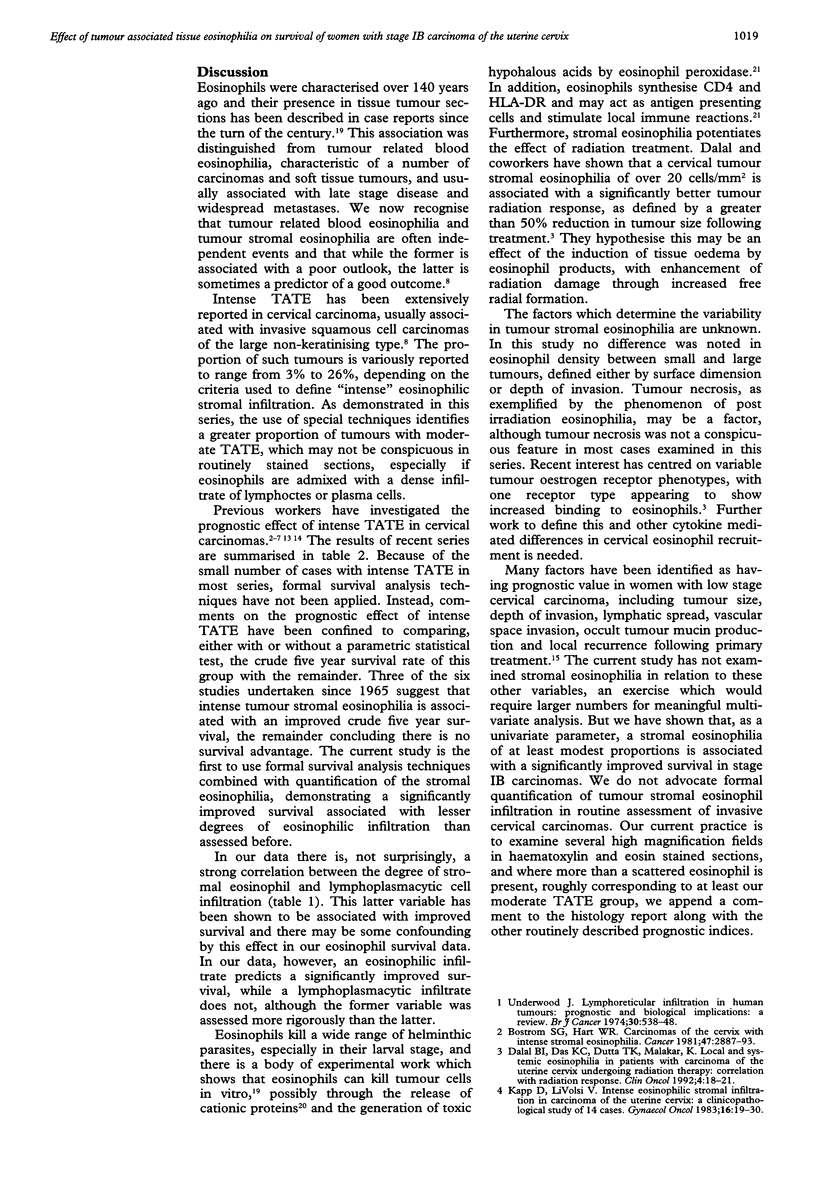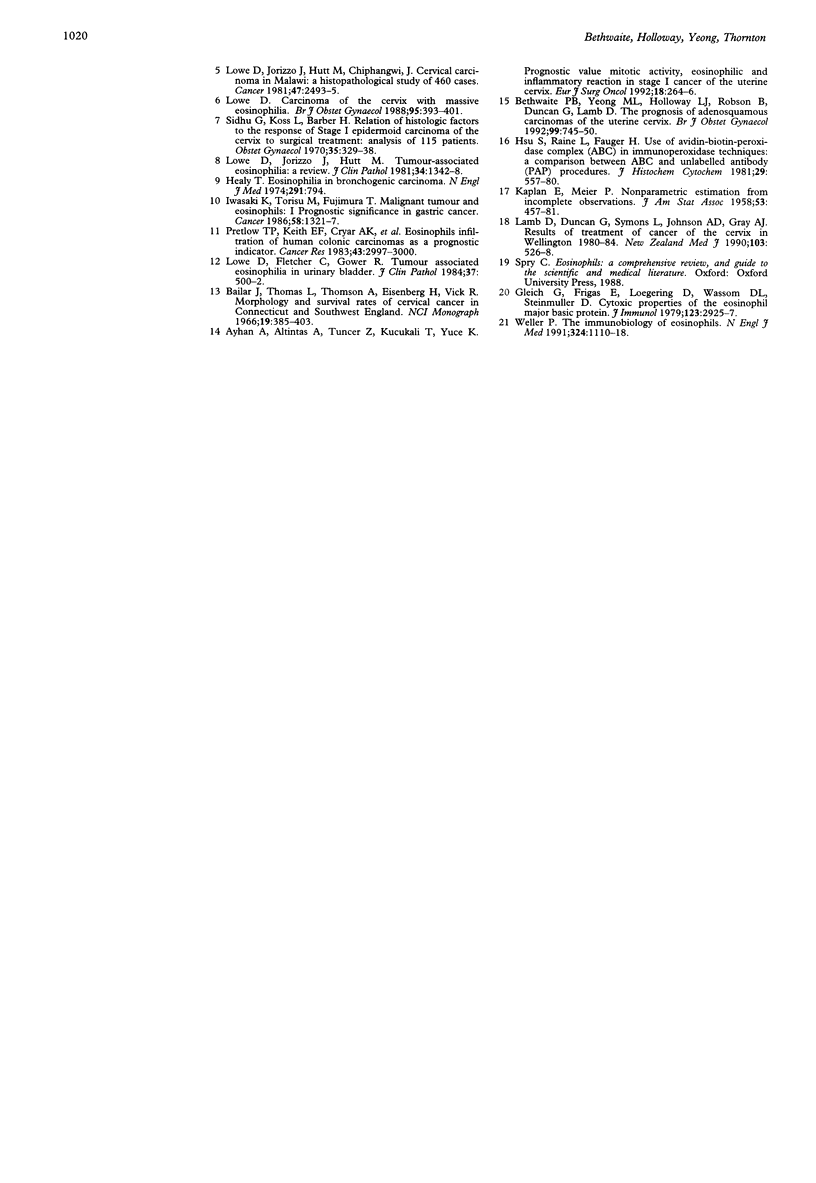Abstract
AIMS--To examine the survival of a group of women with stage IB invasive carcinoma of the uterine cervix, divided according to the expression of tumour associated tissue eosinophilia (TATE). METHODS--Histological material from 81 women with stage IB squamous and adenosquamous cervical carcinomas before radiotherapy was assessed for the extent of tissue stromal eosinophilia, quantified using antibodies to human major basic protein. RESULTS--Twenty eight (38%) of the cases demonstrated TATE of over 30 eosinophils/mm2, with 12 (16%) having greater than 100 eosinophils/mm2. Eleven women in the series developed distant spread or recurrent pelvic disease, this group having a stromal eosinophil density significantly less (13.8/mm2) than the remainder (69.9/mm2) (p = 0.03). The actuarial five year survival rate for women with a tumour eosinophil density over 30/mm2 was 92% compared with 70% with a density under 30 mm2, with a significant difference in the survival curves for these two groups (p = 0.03). CONCLUSIONS--As a univariate parameter, a tumour associated tissue eosinophilia of at least modest proportions is associated with statistically improved survival in women with stage IB cervical carcinomas.
Full text
PDF




Selected References
These references are in PubMed. This may not be the complete list of references from this article.
- Ayhan A., Altintaş A., Tuncer Z. S., Kükali T., Yüce K. Prognostic value of mitotic activity, eosinophilic and inflammatory reaction in stage I cancer of the uterine cervix. Eur J Surg Oncol. 1992 Jun;18(3):264–266. [PubMed] [Google Scholar]
- Bailar J. C., 3rd, Thomas L. B., Thomson A. D., Eisenberg H., Vick R. M. Morphology and survival rates of cervical cancer in Connecticut and southwest England. Natl Cancer Inst Monogr. 1966 Jan;19:385–403. doi: 10.1002/1097-0142(196603)19:3<385::aid-cncr2820190312>3.0.co;2-s. [DOI] [PubMed] [Google Scholar]
- Bethwaite P., Yeong M. L., Holloway L., Robson B., Duncan G., Lamb D. The prognosis of adenosquamous carcinomas of the uterine cervix. Br J Obstet Gynaecol. 1992 Sep;99(9):745–750. doi: 10.1111/j.1471-0528.1992.tb13877.x. [DOI] [PubMed] [Google Scholar]
- Bostrom S. G., Hart W. R. Carcinomas of the cervix with intense stromal eosinophilia. Cancer. 1981 Jun 15;47(12):2887–2893. doi: 10.1002/1097-0142(19810615)47:12<2887::aid-cncr2820471223>3.0.co;2-3. [DOI] [PubMed] [Google Scholar]
- Dalal B. I., Das K. C., Dutta T. K., Malakar K. Local and systemic eosinophilia in patients with carcinoma of the uterine cervix undergoing radiation therapy: correlation with radiation response. Clin Oncol (R Coll Radiol) 1992 Jan;4(1):18–21. doi: 10.1016/s0936-6555(05)80766-6. [DOI] [PubMed] [Google Scholar]
- Gleich G. J., Frigas E., Loegering D. A., Wassom D. L., Steinmuller D. Cytotoxic properties of the eosinophil major basic protein. J Immunol. 1979 Dec;123(6):2925–2927. [PubMed] [Google Scholar]
- Healy T. M. Letter: Eosinophilia in bronchogenic carcinoma. N Engl J Med. 1974 Oct 10;291(15):794–794. [PubMed] [Google Scholar]
- Iwasaki K., Torisu M., Fujimura T. Malignant tumor and eosinophils. I. Prognostic significance in gastric cancer. Cancer. 1986 Sep 15;58(6):1321–1327. doi: 10.1002/1097-0142(19860915)58:6<1321::aid-cncr2820580623>3.0.co;2-o. [DOI] [PubMed] [Google Scholar]
- Kapp D. S., LiVolsi V. A. Intense eosinophilic stromal infiltration in carcinoma of the uterine cervix: a clinicopathologic study of 14 cases. Gynecol Oncol. 1983 Aug;16(1):19–30. doi: 10.1016/0090-8258(83)90004-5. [DOI] [PubMed] [Google Scholar]
- Lamb D. S., Duncan G. R., Symons L. A., Johnson A. D., Gray A. J., Spry N. A. Results of treatment of cancer of the cervix in Wellington 1980-4. N Z Med J. 1990 Nov 14;103(901):526–528. [PubMed] [Google Scholar]
- Lowe D. G. Carcinoma of the cervix with massive eosinophilia. Br J Obstet Gynaecol. 1988 Apr;95(4):393–401. doi: 10.1111/j.1471-0528.1988.tb06613.x. [DOI] [PubMed] [Google Scholar]
- Lowe D., Fletcher C. D., Gower R. L. Tumour-associated eosinophilia in the bladder. J Clin Pathol. 1984 May;37(5):500–502. doi: 10.1136/jcp.37.5.500. [DOI] [PMC free article] [PubMed] [Google Scholar]
- Lowe D., Jorizzo J., Chiphangwi J., Hutt M. S. Cervical carcinoma in Malawi: a histopathologic study of 260 cases. Cancer. 1981 May 15;47(10):2493–2495. doi: 10.1002/1097-0142(19810515)47:10<2493::aid-cncr2820471030>3.0.co;2-6. [DOI] [PubMed] [Google Scholar]
- Pretlow T. P., Keith E. F., Cryar A. K., Bartolucci A. A., Pitts A. M., Pretlow T. G., 2nd, Kimball P. M., Boohaker E. A. Eosinophil infiltration of human colonic carcinomas as a prognostic indicator. Cancer Res. 1983 Jun;43(6):2997–3000. [PubMed] [Google Scholar]
- Sidhu G. S., Koss L. G., Barber R. K. Relation of histologic factors to the response of stage I epidermoid carcinoma of the cervix to surgical treatment. Analysis of 115 patients. Obstet Gynecol. 1970 Mar;35(3):329–338. [PubMed] [Google Scholar]
- Underwood J. C. Lymphoreticular infiltration in human tumours: prognostic and biological implications: a review. Br J Cancer. 1974 Dec;30(6):538–548. doi: 10.1038/bjc.1974.233. [DOI] [PMC free article] [PubMed] [Google Scholar]
- Weller P. F. The immunobiology of eosinophils. N Engl J Med. 1991 Apr 18;324(16):1110–1118. doi: 10.1056/NEJM199104183241607. [DOI] [PubMed] [Google Scholar]


